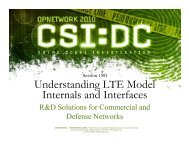Understanding TCP/IP Model Internals and Interfaces
Understanding TCP/IP Model Internals and Interfaces
Understanding TCP/IP Model Internals and Interfaces
Create successful ePaper yourself
Turn your PDF publications into a flip-book with our unique Google optimized e-Paper software.
1508 <strong>Underst<strong>and</strong>ing</strong> <strong>TCP</strong>/<strong>IP</strong> <strong>Model</strong> <strong>Internals</strong> <strong>and</strong> <strong>Interfaces</strong><br />
Analyze <strong>TCP</strong> New Reno<br />
4. Select Scenarios -> Switch to Scenario to switch to scenario New_Reno.<br />
5. <strong>TCP</strong> New Reno supports fast retransmission <strong>and</strong> fast recovery. However, contrary to <strong>TCP</strong> Reno,<br />
it halves the congestion window only once during recovery process.<br />
a. Fast Recovery has been already enabled on both the workstation <strong>and</strong> the server by setting<br />
<strong>TCP</strong> Parameters->Fast Recovery to New Reno:<br />
3. Repeat steps 2 through 3 from page 16 to run the simulation, <strong>and</strong> load results into templates. You<br />
should see the following results:<br />
Results Analysis<br />
Congestion Window<br />
Examine <strong>TCP</strong> Connection.Congestion Window Size (bytes) graph to answer the following.<br />
To get an exact value, point the mouse to the desired point <strong>and</strong> read the tooltip.<br />
1. What was the congestion window size before the packet loss was detected? ___________<br />
2. What did the congestion window size value change to after detecting packet loss? _________<br />
CONFIDENTIAL – RESTRICTED ACCESS: This information may not be disclosed, copied, or transmitted in any format without the prior written consent of OPNET Technologies, Inc.<br />
© 2010 OPNET Technologies, Inc.<br />
26
















